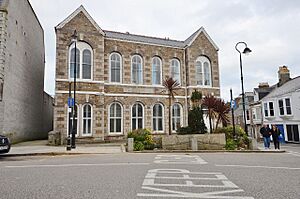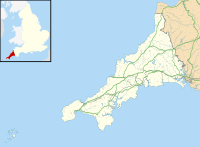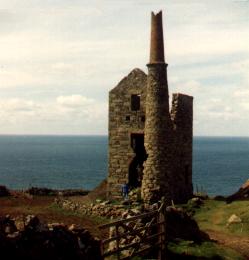Camborne School of Mines facts for kids
 |
|||||||||
| Motto | Laboris Gloria Ludi | ||||||||
|---|---|---|---|---|---|---|---|---|---|
| Type | Public | ||||||||
| Established | 1888 | ||||||||
| Director | Professor Pat Foster | ||||||||
| Location |
,
,
UK
50°10′16″N 5°07′35″W / 50.1711°N 5.1265°W |
||||||||
| Campus | Penryn Campus | ||||||||
| Patron | Queen Elizabeth II | ||||||||
| Colours | Gold, blue, silver
|
||||||||
 |
|||||||||
The Camborne School of Mines (which is Scoll Balow Cambron in Cornish), often called CSM, started in 1888. It's a special place where students learn about the Earth. They study things like how the Earth works, where to find natural resources, and how to protect our environment.
CSM offers different study programs. These include courses in Earth resources, civil engineering, and environmental science. The school is located at the Penryn Campus in Cornwall, UK. This is near the town of Falmouth. In 1993, CSM joined the University of Exeter.
Contents
What CSM is Known For
The Camborne School of Mines is famous around the world. It's known for its work in mining, tunnelling, and studying minerals. People also come here to learn about geology (the study of Earth's rocks and history) and geophysics (the study of Earth's physical processes).
CSM's great reputation began a long time ago. In the 1800s, new mineral deposits were found worldwide. Graduates from CSM went to work in many countries. By the 1900s, you could find CSM graduates in major mining areas. These included places like Southern Africa, Australia, and North America.
Today, CSM still has a strong connection to the global mining industry. This is thanks to its teaching, research, and a network of former students.
What Students Learn
As of 2023, CSM offers several exciting degrees. You can study mining engineering, which is the only program of its kind in the UK. There are also programs in applied geology, and in engineering geology and geotechnics.
For students who have already completed a first degree, CSM offers advanced courses. These include degrees in applied geotechnics, minerals engineering, and mining engineering. You can also study mining geology or surveying and land/environmental management.
In 2003, CSM became part of the Federation of European Mineral Programs (FEMP). This allows students to study in other European countries.
CSM also helps students with scholarships. The Camborne School of Mines Trust and other sponsors offer 15 to 20 scholarships each year. These are for new students joining CSM programs. They are usually given based on how well students have done in their studies.
Students who complete their degrees at CSM can also earn special awards. These are given by the University of Exeter on behalf of the Camborne School of Mines Trust.
- The Associateship of the Camborne School of Mines (ACSM) is for students with BEng and BSc degrees.
- The Master of the Camborne School of Mines (MCSM) is for students with higher degrees like MSc or PhD.
The ACSM and MCSM are special awards in the mining and Earth-related industries. The ACSM has been given to CSM graduates since 1910.
Student Life at CSM
Students at CSM are part of a bigger community. This includes students from Falmouth University and the University of Exeter Cornwall Campus. The CSM student association helps organize fun events. They also support students with any questions or problems.
Sports are very popular at CSM. There are team sports that play in local leagues under the CSM name. These teams are open to all students at the campus. A very important event each year is the Bottle Match. This is a sports competition against the Royal School of Mines. The student association organizes this exciting event.
Every year, CSM students also take part in the International Mining Games. These games test skills related to mining. CSM hosted the games in 2012 and 2018 at King Edward Mine. This mine used to be a teaching place for CSM. The CSM teams practice at King Edward Mine. They are looking forward to hosting the games there again in 2025.
The Camborne School of Mines Association is for all former students. It was started in 1896 and has about 1,000 members.
Research at CSM
CSM is a well-known place for research. They study how the Earth's natural resources are formed. They also research how to find, extract, and use these resources. Another important area is how to clean up the environment afterwards.
Much of CSM's research is practical. They work with companies around the world. This shows how useful their research is in the real world.
Research at CSM is organized into three main groups. These groups combine different areas of study. They use the school's knowledge in mining, geology, renewable energy, and environmental science. They also work with experts from the University of Exeter's Geography Department.
These research groups include professors, researchers, and students. Their work is supported by grants from research councils, industries, and charities. They also have great technical staff and special labs to help with their studies.
Facilities and Labs
CSM has many useful facilities and services. These are for students, teachers, and research partners. Businesses can also use them. They offer short courses and training. These include courses on renewable energy and how to use explosives safely in quarries.
The school has amazing labs for studying rocks and minerals. One special lab cost £1.5 million. It has many tools to prepare and analyze samples. These include powerful optical microscopes and a scanning electron microscope. They also have machines like QEMSCAN for identifying minerals. Other tools include X-ray machines and atomic absorption spectrometers.
For mining and engineering, CSM has outdoor testing areas. They have modern surveying equipment. This includes a special Gyromat 2000 Precision Gyrotheodolite. They also have a triaxial test rig for testing soil and rock strength.
Field Station
In May 2017, CSM lost its underground field station. This was near Camborne. The site was sold to another company. This meant they could no longer do research on blast vibrations or underground mining there. It also ended the annual student mining courses. These courses had been held there since the 1960s.
Museum
CSM has a museum dedicated to geology from all over the world. It focuses on mining and minerals. The museum has a large collection of minerals. These include glowing minerals, gemstones, and ore minerals. It also has rock samples from important mining areas worldwide. A big part of the collection comes from southwest England.
This collection helps teach geology throughout Cornwall. It is also used a lot for teaching at the school. You can visit the displays in CSM's entrance area for free. They are open Monday to Friday, from 9 AM to 5 PM. The museum also has old items related to mining history. This collection is made even better by the King Edward Mine Museum.
History of CSM
The Camborne School of Mines has a long and interesting history. Here are some key moments:
- 1829: John Taylor suggested creating a School of Mines in Cornwall.
- 1838: Sir Charles Lemon offered to start a school for miners.
- 1839: Classes for miners began in Truro.
- 1858: The Miners Association was formed. They started classes in different mining areas of Cornwall. These included Camborne, Pool, and St Just.
- 1863: About 200 students were taking classes in eleven mining education centers in Cornwall.
- 1876: Gustavus Lambert Basset, a famous mine owner, left money to build a lab in Camborne. This was for students of The Miners Association.
- 1888: The Camborne School of Mining was officially created.
- 1897: King Edward Mine was leased. This gave students a place for hands-on practice.
- 1902: The first Bottle Match was played between CSM and the Royal School of Mines (RSM).
- 1910: The Schools of Mines from Redruth and Penzance joined with Camborne. They formed the Camborne School of Metalliferous Mining.
- 1924: King Edward Mine was no longer used due to flooding. Great Condurrow Mine was leased instead.
- 1936: The Associateship of the Camborne School of Mines (ACSM) award was introduced.
- 1975: CSM moved to the Trevenson Campus in Pool, Redruth.
- 1979: The original CSM Building was taken down to build a supermarket.
- 1993: CSM merged with the University of Exeter.
- 2004: CSM moved to the Tremough Campus in Penryn. They got a new building and lots of new equipment.
- 2020: The Mining Engineering degree program paused new student intake. CSM was the last place in the UK to offer this degree.
- 2023: The Mining Engineering degree program started again. It now includes a 4-year BEng and Mine Management Degree Apprenticeships.
Leaders of CSM
Here are some of the people who have led the Camborne School of Mines:
- J. J. Beringer: 1888–1910 and 1912–1915
- W. Ficher Wilkinson: 1910–1912
- R.A. Gorges: 1960–1969
- P. Hackett: 1970–1994
- K. Atkinson: 1994–2002
- R. J. Pine: 2002–2008
- F. Wall: 2008–2014
- K. Jeffrey: 2015–2021
- S. Hesselbo: 2021–2022
- P.J.Foster: 2022 – present
Famous Former Students
Many notable people have studied at CSM, including:
- James Howard Williams, known as Elephant Bill
- Percy Sherwell, a famous South African cricketer
- Eric Roberts, an MI5 agent during World War II
- Sam E. Jonah, former CEO of Ashanti Goldfields Corporation
- Arthur Wilson, an England rugby player and Olympic team member
- Geoffrey Healey, an automotive engineer famous for Austin-Healey cars
See also
- The Mining Association of the United Kingdom
- Institution of Mining and Metallurgy
- Mining in Cornwall and Devon



